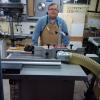The title of the post pretty well sums up the question. I raise it because I've noticed some posts in the archives from people who suggest the thrust bearing spinning at all means either the blade is dull or there is not enough tension being applied. One post made a case that the thrust bearing should not even be necessary other than a warning gauge that you're not using enough tension.
Logic would say feed rate and blade choice (width, tpi, gullet size, set) must also play into this balance. How far you set the thrust bearing back from the blade surely is a factor also. I tend to set mine close, maybe 1/32" back, just outside of touching the blade when turning the wheel by hand.
What about others? Are you in the spin or no spin camp? Lazy or banshee spin? Maybe some don't pay attention to the thrust bearing spin rate much at all?
Thanks for commenting!
Edwin




 Reply With Quote
Reply With Quote





